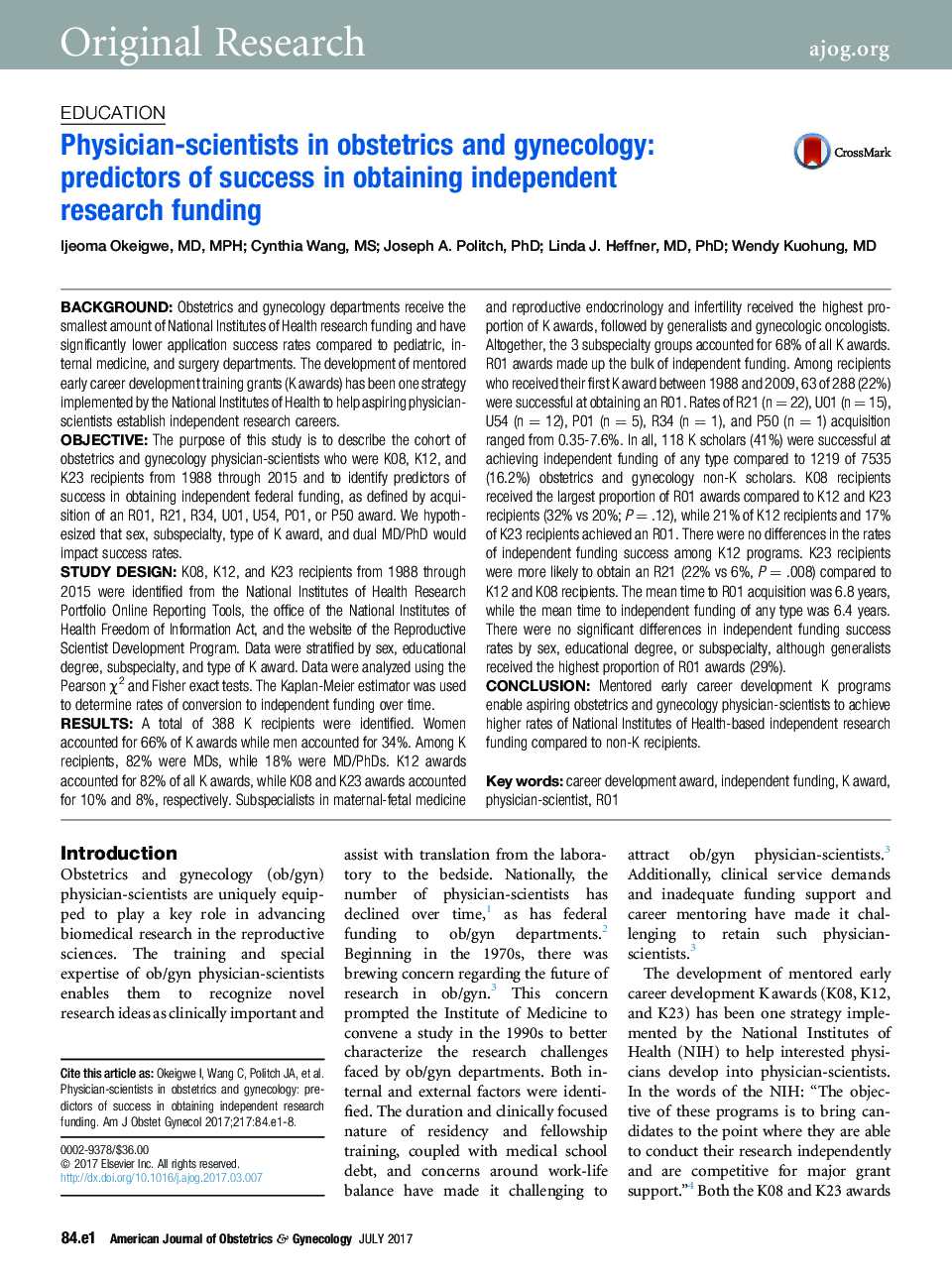| کد مقاله | کد نشریه | سال انتشار | مقاله انگلیسی | نسخه تمام متن |
|---|---|---|---|---|
| 5675732 | 1594874 | 2017 | 8 صفحه PDF | دانلود رایگان |
BackgroundObstetrics and gynecology departments receive the smallest amount of National Institutes of Health research funding and have significantly lower application success rates compared to pediatric, internal medicine, and surgery departments. The development of mentored early career development training grants (K awards) has been one strategy implemented by the National Institutes of Health to help aspiring physician-scientists establish independent research careers.ObjectiveThe purpose of this study is to describe the cohort of obstetrics and gynecology physician-scientists who were K08, K12, and K23 recipients from 1988 through 2015 and to identify predictors of success in obtaining independent federal funding, as defined by acquisition of an R01, R21, R34, U01, U54, P01, or P50 award. We hypothesized that sex, subspecialty, type of K award, and dual MD/PhD would impact success rates.Study DesignK08, K12, and K23 recipients from 1988 through 2015 were identified from the National Institutes of Health Research Portfolio Online Reporting Tools, the office of the National Institutes of Health Freedom of Information Act, and the website of the Reproductive Scientist Development Program. Data were stratified by sex, educational degree, subspecialty, and type of K award. Data were analyzed using the Pearson Ï2 and Fisher exact tests. The Kaplan-Meier estimator was used to determine rates of conversion to independent funding over time.ResultsA total of 388 K recipients were identified. Women accounted for 66% of K awards while men accounted for 34%. Among K recipients, 82% were MDs, while 18% were MD/PhDs. K12 awards accounted for 82% of all K awards, while K08 and K23 awards accounted for 10% and 8%, respectively. Subspecialists in maternal-fetal medicine and reproductive endocrinology and infertility received the highest proportion of K awards, followed by generalists and gynecologic oncologists. Altogether, the 3 subspecialty groups accounted for 68% of all K awards. R01 awards made up the bulk of independent funding. Among recipients who received their first K award between 1988 and 2009, 63 of 288 (22%) were successful at obtaining an R01. Rates of R21 (n = 22), U01 (n = 15), U54 (n = 12), P01 (n = 5), R34 (n = 1), and P50 (n = 1) acquisition ranged from 0.35-7.6%. In all, 118 K scholars (41%) were successful at achieving independent funding of any type compared to 1219 of 7535 (16.2%) obstetrics and gynecology non-K scholars. K08 recipients received the largest proportion of R01 awards compared to K12 and K23 recipients (32% vs 20%; P = .12), while 21% of K12 recipients and 17% of K23 recipients achieved an R01. There were no differences in the rates of independent funding success among K12 programs. K23 recipients were more likely to obtain an R21 (22% vs 6%, P = .008) compared to K12 and K08 recipients. The mean time to R01 acquisition was 6.8 years, while the mean time to independent funding of any type was 6.4 years. There were no significant differences in independent funding success rates by sex, educational degree, or subspecialty, although generalists received the highest proportion of R01 awards (29%).ConclusionMentored early career development K programs enable aspiring obstetrics and gynecology physician-scientists to achieve higher rates of National Institutes of Health-based independent research funding compared to non-K recipients.
Journal: American Journal of Obstetrics and Gynecology - Volume 217, Issue 1, July 2017, Pages 84.e1-84.e8
